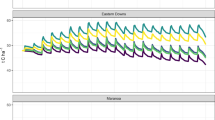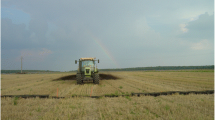Abstract
The goal of this paper is to put the issue of preserving Soil Organic Matter (SOM) into a regional, urban-rural, context. In doing so, we apply the method of material flux analysis to a watershed in Boyacá in Colombia. We estimate the order of magnitude of the dry organic matter and carbon fluxes between the rural and urban parts of the region, including estimates on biomass growth, tillage, organic waste, and sewage. These estimates are used to derive potentials for carbon cycling between rural and urban areas. It is shown that (i) for the municipality of Tunja, the treated organic wastes produced in the urban area could add about 30% to the current carbon input into arable soils; (ii) to preserve the organic carbon content in soils in Tunja over the long-term, either, erosion control measures have to be implemented and/or the total treated urban organic wastes have to be concentrated on about 1/5 of the agricultural area. However, such an attempt has to consider the possible trade off between allocation needs (poor farmers on the hillside) and allocation costs (transportation and distribution costs).
Similar content being viewed by others
References
Alba Gonzales RE, Alvarado Gonzales OF, Rojas Gil LJ & Ruiz Garcia SA (1998) Analysis de Flujo de Materiales para la Zona Rural del Centro del Departamento de Boyaca. Facultad de Ciencias e Ingenieria. Tunja, Fundacion Universitaria de Boyaca
Aliva Neira YS & Rincon Suarez HA (1998) Aplicacion del Modelo EPIC para la Determinacion de Fosforo como Consecuencia de los Procesos de Erosion y Escurrimiento de la Zona Rural del Centro del Departamento de Boyaca Facultad de Ciencias e Ingenieria. Tunja, Fundacion Universitaria de Boyaca
Anjos LH, Fernandes MR, Pereira MG & Franzmeier DP (1998) Landscape and Pedogenesis of an Oxisol-Inceptisol-Ultisol Sequence in Southeastern Brazil. Soil Sci Soc Am J 62: 1651–1658
Baccini P & Brunner P (1991) Metabolism of the Anthroposphere. New York, Springer
Baccini P & Von Steiger B (1993) Die Stoffbilanzierung landwirtschaftlicher Böden-Eine Methode zur Früherkennung von Bodenveränderungen. Z Pflanzenernähr Bodenk 156: 45–54
Baccini P & Bader H-P (1996) Regionaler Stoffhaushalt. Erfassung, Bewertung und Steuerung. Heidelberg, Spektrum Akademischer Verlag
Binder C (1996) The Early Recognition of the Environmental Effect of Human Activities in Developing Countries. PhD Thesis, Department of Resource and Waste Management. Swiss Federal Institute of Technology, Zürich
Binder C, Schertenleib R, Diaz J & Baccini P (1997) Regional water balance as a tool for water management in developing countries. Water Res Manag 13: 5–20
Bosch Hvd, De Jaeger A & Vlaming J (1998) Monitoring nutrient flows and economic performance in African farming systems (NUTMON) II. Tool development. Agric Ecosyst Environ 71: 49–62
Bormann FH & Likens GE (1969) The watershed-ecosystem concept and studies of nutrient cycles. In: Van Dyne GM(ed) The Natural Resource Ecosystem, pp. 49–76. New York, London: Academic Press
Brady NC, Weil RR (1996) The Nature and Properties of Soils, New Jersey: Prentice-Hall Inc
Cross P & Strauss M(1985) Health Aspects of Nightsoil and Sludge Use in Agriculture and Aquaculture. Dübendorf, International Centre for Waste Disposal (IRCWD)
DANE (1994) Censo 1993. Bogota: DANE
Diaz J (1998) Tratamiento de Aguas Residuales Domesticas del Municipio de Tunja por medio de un reactor UASB de dos compartimientos operando en el rango psicrofilico de temperatura. Tunja, Fundacion Universitaria de Boyaca
Draaijer E (1992) Performance of the 5 MLD UASB reactor for sewage treatment at Kanpur, India. Water Sci Tech 25: 123–133
EAAT (1993) Statistics and personal communications, Javier Rodriguez. Tunja, Empresa de Acueducto y Alcantarillado Tunja
Gijsman AJ, Alarcon HF & Thomas RJ (1997) Root decomposition in tropical grasses and legumes, as affected by soil texture and season. Soil Biol Biochem 29: 1443–1450
Gorraiz V (1988) Estudio Propuesta de Recolleccion, Tratamineto y Disposicion Optima de los Residuos Solidos para la Ciudad de Tunja. Facultad de Ciencias e Ingenieria. Tunja, Fundacion Universitaria de Boyaca
Graff O (1995) Geschichte der organischen Düngung: von Stercutus bis heute. Hamburg, Verlag Dr. Kovac
Haase R (1992) Physical and chemical properties of Savanna soils in Northern Bolivia. CATENA 19: 119–134
Hu S, Coleman DC, Carroll CR, Handrix PF & Baere MH (1997) Labile soil carbon pools in subtropical forest and agricultural ecosystems as influenced by management practices and vegetation types. Agric Ecosyst Environ 65: 69–78
Hunter DJ, Yapa LGG & Hue NV (1997) Effects of green manure and coral lime on corn growth and chemical properties of an acid Oxisol in Western Samoa. Biol Fertil Soils 24: 266–273
Jenkinson DS & Anayaba A (1977) Decomposition of carbon-14 labeled plant material under tropical conditions. Soil Sci Soc Am J 41: 921–915
Khaleel R, Reddy RK & Overcash MR (1981) Changes in soil physical properties due to organic waste applications: A Review. J Environ Qual 10: 133–141
Kirchmann H & Bernal MP (1997) Organic waste treatment and C stabilization efficiency. Soil Biol Biochem 29: 1747–1753
Leitzinger CH (2000) Ist eine Co-compostierung aus stofflicher Sicht in Kumasi/Ghana sinnvoll? Diploma Thesis, Swiss Federal Institute of Technology, Zürich
Lindeman RL (1942) The trophic-dynamic aspect of ecology. Ecology 23: 399–418
Lynam JK, Nandwa SM & Smaling EMA (1998) Nutrient balances as indicators of productivity and sustainability in sub-saharan agriculture. Introduction to the Special Issue. Agric Ecosyst Environ 71: 1–4
Müller DB, Oehler D & Baccini P (1995) Regionale Bewirtschaftung von Biomasse; Eine stoffliche und energetische Beurteilung der Nutzung von Agrarflächen mit Energiepflanzen. vdf Zürich
Nandwa SM & Bekunda MA (1998) Research on nutrient flows and balances in East and Southern Africa: state-of-the-art. Agric Ecosyst Environ 71: 5–18
Nyhan JW (1976) Influence of soil temperature and water tension on the decomposition rate of carbon-14 labeled herbage. Soil Sci 121: 288–293
Odum HT (1955) Time's speed regulator: the optimum efficiency for maximum power output in physical and biological systems. Am Sci 43: 331–343
Obeng LA & Wright FW (1987) Integrated Resource Recovery: The Co-composting of Domestic Solid and Human Wastes. Washington, DC: The World Bank
Obrist W (1987) Material balance of the composting process. BioCycle 28: 32–33
Pagliai M & Antisari VL (1993) Influence of waste organic matter on soil micro-and macrostructure. Biores Tech 43: 205–213
Pascual JA, T Hernandez, Garcia C & Ayuso M(1998) Carbon mineralization in an arid soil amended with organic wastes of varying degree of stability. Commun Soil Sci Plant Anal 29: 835–846
Recktenwald HC & Samuelson PA (1986) Thünen - ein Klassiker in unserer Zeit. Mainz: Franz Steiner Verlag
Rohrer T & Geiger M (1998) Komposttoiletten-Information für die Praxis. Steinhuserberg, Zentrum für Angewandte Oekologie Schattweid
Samuelson PA (1987) Thünen nach 200 Jahren. Eine moderne Würdigung. Thünen - ein Klassiker unserer Zeit. H. C. Recktenwald, Samuelson, P.A. Wiesbaden und Stuttgart, Akademie der Wissenschaften und der Literatur, Mainz: 25–69
Scoones I & Toulmin C (1998) Soil nutrient balances: what use for policy? Agric Ecosyst Environ 71: 255–267
Shang C & Tiessen H (1997) Organic matter lability in a tropical Oxisol: Evidence from shifting cultivation, chemical oxidation, particle size, density, and magnetic fractionations. Soil Science (USA) 162: 795–807
Shang C & Tiessen H (1998) Organic matter stabilization in two semiarid tropical soils: Size, density, and magnetic Separations. Soil Sci Soc Am J 62: 1247–1247
Shuval HI, Gunnerson CG & Julius DAS (1981) Appropriate Technology forWater Supply and Sanitation: Night Soil Composting. Washington, DC: The World Bank
Sheperd KD & Soule MJ (1998) Soil fertility management in west Kenya: dynamic simulation of productivity, profitability and sustainability at different resources endowment levels. Agric Ecosyst Environ 71: 131–145
Stoorvogel JJ & Smaling EMA (1990) Assessment of soil nutrient depletion in Sub-Saharan Africa: 1983-2000. Volume I: Main report. Report 28. The Winand Staring Centre, Wageningen
Von Thünen JH (1826) Der isolierte Staat in Beziehung auf Landwirtschaft und Nationalökonomie. Untersuchungen über den Einfluss, den die Getreidepreise, der Reichtum des Bodens und die Abgaben auf den Ackerbau ausüben. Hamburg
Tiessen H, Cuevas E & Chacon P (1994) The role of soil organic matter stability in soil fertility and agricultural potential. Nature 371: 783–785
URPA (1995) Diagnóstico Agropecuario de Boyacá. Tunja, Ministerio de Agricultura y Desarrollo Rural
Weeraratna CS & Asghar M (1990) Effects of grass and mulches on some soil (an Inceptisol) properties and yield of taro (Colocasia esculenta) in Western Samoa. Trop Agriculture (Trinidad) 69: 83–86
Author information
Authors and Affiliations
Corresponding author
Rights and permissions
About this article
Cite this article
Binder, C., Patzel, N. Preserving tropical soil organic matter at watershed level. A possible contribution of urban organic wastes. Nutrient Cycling in Agroecosystems 61, 171–181 (2001). https://doi.org/10.1023/A:1013394927257
Issue Date:
DOI: https://doi.org/10.1023/A:1013394927257




